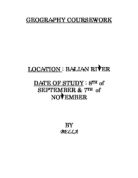Site 2: 16km from source
Site 3: 17 km From source
It is important to study the rivers and systems, so we know what to expect and will be able to control them in different ways Leaves example - where the rivers it will not lead to a disaster to the surrounding villages as we all know that if a major river flood can cause devastation as when the Mississippi flooded in New Orleans in 2005. Therefore studying the history and the rivers we have Aid to bring about the prevention of floods. However, the study of rivers in the summer is different than in the winter because the river depth varies depending more rain in winter than in summer. This will also affect other functions of the river e.g. there will be more rain; there will be more and faster erosion. This means that rivers have a different reading of the measurements throughout the year when the weather is changing constantly.
This is the ‘Bradshaw Model’. On the left part of the diagram is when the river is in the upper course when on the right is when the river descends to its lower course.
River discharge:
Discharge is when the river reaches it maximum peak of water capacity. According to the Bradshaw Model, the river discharges in its lower course most. The reason for discharge is due to the increase of water in the river – through rain, surface run-off…etc.
Occupied channel width:
The occupied channel width is the distance of which the water covers from one end to the other. This varies due to the discharge of the river. This means that on dry days, the occupied channel width is short, whereas on rainy days, the measurement will read quite long. This also means that the river get widens in the lower course.
Channel depth:
Channel depth is the height from the water surface to the river bed. The depth increases downstream because
Of the amount of water which increases due to the input
From tributaries.
Average velocity:
Average velocity is the speed of the river going downstream. According to the Bradshaw Model, the velocity gently increases downstream
There are three factors which influence the velocity:
- Gradient – the steeper the gradient the faster the water flows.
- Channel roughness – the rougher the channel the slower the water flows i.e. if there’s big boulders in the river, the water will have to go round them, slowing the flow. If however, it was a smooth channel i.e. no boulders or obstructions, the river will flow quite faster.
- Shape of Channel – the shape of channel affects the velocity.
Load quantity: The amount of charge is the ability to which the water may contain. The increased discharge capacity and speed for example if the depth of the river rises, it may contain more load and the speed increases, which means the river can have more energy and will be able to carry more load. According to Bradshaw style, the load will increase the downstream because of the depth and velocity of the river.
Load particle size: The size of particles in the river will gradually decrease going downstream. The reason is mainly due to the different types of corrosion and attrition. Corrosion is when the river carries its load with it and it rubs against the bank wearing it creating a sandpaper effect. Meanwhile attrition is when the stones were carried by the river that hit each other and making the stones into smaller rounded pebbles. Finally, the stones will be reduced to a particle size of silt.
My hypotheses will be based on Bradshaw’s model. They are:
- Channel depth will increase downstream
- Average velocity will increase downstream
- Channel depth will increase downstream
My predictions:
- Average velocity – according to Bradshaw’s model, I expect the velocity of the river to increase downstream.
- Load particle size – expected to decrease downstream
- Channel depth – to increase downstream








